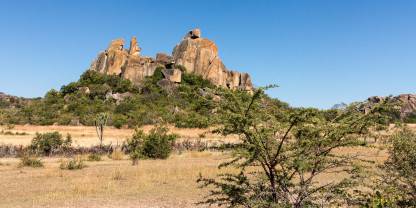Average Expert Rating
Rating Breakdown
Write a User ReviewScenically Stunning but With Only Limited Wildlife
Also referred to as the Matopos, this small national park and Unesco World Heritage Site was primarily established to protect a section of the Matobo Hills – the unique boulder-strewn landscapes of southern Zimbabwe. Extruded granite has been weathered and eroded over time to form the iconic smooth whalebacks and ubiquitous broken koppies that pepper this park. There is no denying that the Matobo Hills exude a powerful wilderness vibe, as well as unusual and arresting scenery, but it’s not a place you would choose to visit on your safari if you want to see large numbers of wild animals. Legions of leopards are said to reside within this prime hilly habitat, but in three visits to the region, I’ve never spotted one.
A Solid Granite Plateau Best-Known for Rock Art and Rhino-Spotting
While I’ve always easily seen wildebeest, giraffe, zebra and common species of antelope in Matobo’s wooded valleys, I don’t find this park particularly special in terms of game viewing. There’s a high concentration of leopard, but with no opportunity to do night drives these remain pretty elusive, and elephant and lion aren’t present. But there are exceptions: I’ve never had any problem locating both black and white rhino (which breed here successfully), baboons and vervet monkeys can be seen scrambling over the rocks, and I find the semi-tame multi-coloured agama lizards in the car parks oddly absorbing. Additionally, Matobo’s numerous rock paintings are fairly interesting, and the grave of British imperialist Cecil John Rhodes at World’s View is a good vantage point from which to see the park’s distinctive granite balancing rocks.

